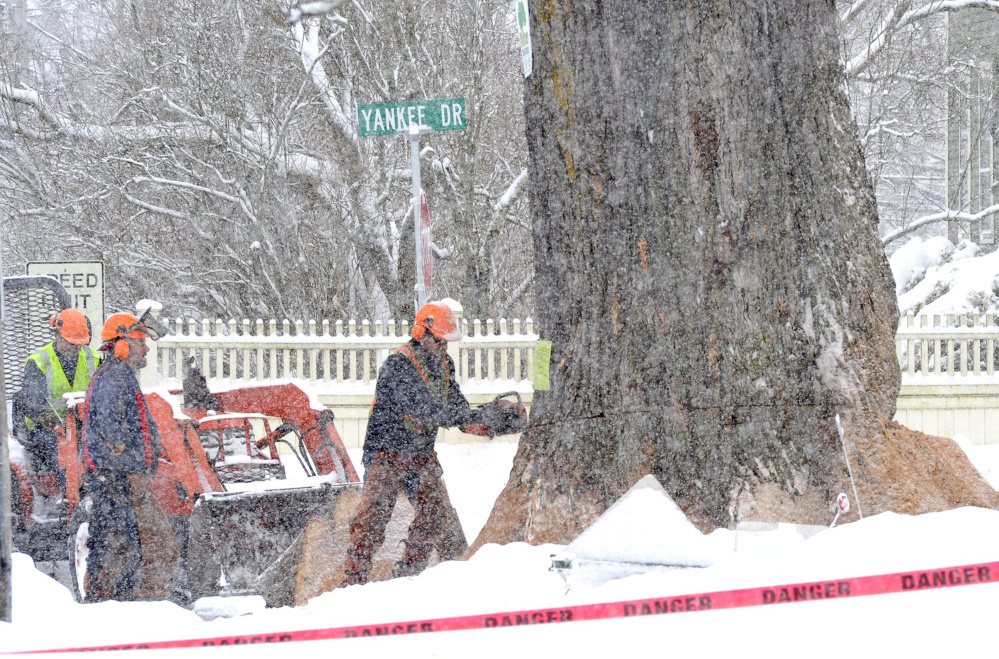SPRINGFIELD, Mass. — Decades ago, the streets of New England were lined with majestic American elm trees. By the 1970s, most of the trees had died and were cut down as a result of Dutch elm disease, a fungus spread by the elm bark beetle.
Now scientists are working to develop disease-resistant strains of the iconic and once-common tree species, and the Pioneer Valley of western Massachusetts is one prime location for that effort.
On a bitterly cold morning recently, Nature Conservancy ecologist Christian Marks and arborist James McSweeney of Hilltown Tree and Garden in Chesterfield set out to collect branches from a large American elm in Northampton that had survived successive waves of Dutch elm disease.
The tree near the Connecticut River is one of about 20 such specimens across New England that Marks will collect samples from this year.
McSweeney, bundled up in a fur hat and insulated jumpsuit, used tree-climbing gear to hoist himself into the air. He positioned himself within an upper fork of the tree, where he cut budding branches and dropped them to the ground for Marks to retrieve, wrap, and carefully package for delivery.
Marks said the branches would be rushed to a U.S. Forest Service research station in Ohio. There, a team will cross the pollen with other disease-tolerant trees to create offspring. The process aims for genetic strength and diversity, he said. The young saplings at a certain point will be injected with the disease. Those that don’t succumb will then be planted at floodplain forest restoration sites across New England.
Elwell Island, located in the Connecticut River near the Norwottuck Rail Trail bridge in Northampton, is one of those restoration sites. “It’s a perfect location, because elms love floodplain forest habitat,” said Marks. “They were once prevalent here, and served an important ecological function.”
Marks said that many people still fondly remember the majestic elm trees lining city streets and forming tall canopies along riverbanks.
The disease, thought to be of Asian origin, was first introduced into the United States in the 1930s. The fungus, spread by the beetles and through root systems, leads to a clogging of the vascular system of the tree. The first signs are withering and yellowed leaves. The wholesale loss of American elms not only changed urban streetscapes, but changed the ecology of the floodplain forest in New England, Marks said.
American elm trees still sprout in the New England forest, but they generally die after only a few years, said Kim Lutz, director of the Connecticut River Program for the Nature Conservancy.
Marks said he has learned about the presence of large, disease-resistant elms throughout New England partly through his own explorations, and partly through tips submitted by members of the public.
“These older trees may hold the key to re-establishing the American elm,” he said.
McSweeney, who said he’s worked with Marks for several years, brought his pet goat Luna to the job. Luna protested loudly while McSweeney was in the air, and only quieted down when he landed safely on the ground. “She likes to come along,” he said.
Marks will discuss the Nature Conservancy’s work in the area of floodplain forests and the American elm at a March 12 symposium at Massachusetts Audubon’s Arcadia Wildlife Sanctuary in Easthampton. The symposium will focus on the ecology of the Pioneer Valley.
Send questions/comments to the editors.



Success. Please wait for the page to reload. If the page does not reload within 5 seconds, please refresh the page.
Enter your email and password to access comments.
Hi, to comment on stories you must . This profile is in addition to your subscription and website login.
Already have a commenting profile? .
Invalid username/password.
Please check your email to confirm and complete your registration.
Only subscribers are eligible to post comments. Please subscribe or login first for digital access. Here’s why.
Use the form below to reset your password. When you've submitted your account email, we will send an email with a reset code.